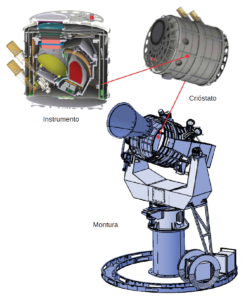The cosmic microwave background (CMB) is the remnant radiation, a relic of the origin of the Universe, which remained from the decoupling of photons from matter, an event
which took place during the early Universe, 380,000 years after the Big Bang. Its detection in 1964 and that of its very small temperature fluctuations in 1992, thanks to the COBE satellite – both discoveries celebrated by Nobel laureates – are among the main scientific advances of the 20th century. The WMAP (2001-2010) and Planck (2009-2013) missions improved the angular resolution and achieved greater sensitivity in measurements.
In-depth studies in the 21st century by the WMAP and Planck space telescopes have led us to a more comprehensive understanding
profound history of our Universe.
The very weak polarized signal of the CMB requires even more complex and sensitive experiments than those developed so far to be able to detect it. To face this challenge, the Collaboration in the QUBIC Project has developed a completely new instrument. It is enclosed in a 1.8m high and 1.6m diameter cylindrical shell or cryostat, which protects and maintains it at -269 ° C. It is open to the sky through a 45cm diameter window made of rigid high-density polyethylene, transparent to the microwave radiation that the experiment tries to measure; meticulously and in detail examines the space at two frequencies: 150 and 220GHz, and records said radiation with a new technique, hybrid between two techniques used in CMB studies (called respectively interferometry and bolometry) through a set of 1024 photodetectors, whose signals allow to analyze the characteristics of the radiation under study. To detect the signal, the cryostat will be globally cooled to 4K (corresponding to -269.15 ° C, only 4 ° C, above absolute zero), but bolometric sensors must work at temperatures 10 times lower (~ 300 mK ). This implies the design of a complex cooling system, specially designed for QUBIC.
The instrument was designed by the members of the international collaboration QUBIC and is under construction in different Argentine and European laboratories and institutes. In France, work is being done on detectors, the design of their mechanics, reading electronics and programming; in Italy, on the cryostat, mirrors, antenna horns and connectors; in Ireland, on optical simulations; in England, on the design of the horn detector, internal cryogenics, filters and polarizer, and in Argentina, on the adequacy of the site, its infrastructure and the mechanical design of the mount.
Argentina has experience in building and operating facilities for large experimental physics projects, for example, due to its participation in the Pierre Auger cosmic ray observatory, located in Malargüe, Mendoza.

